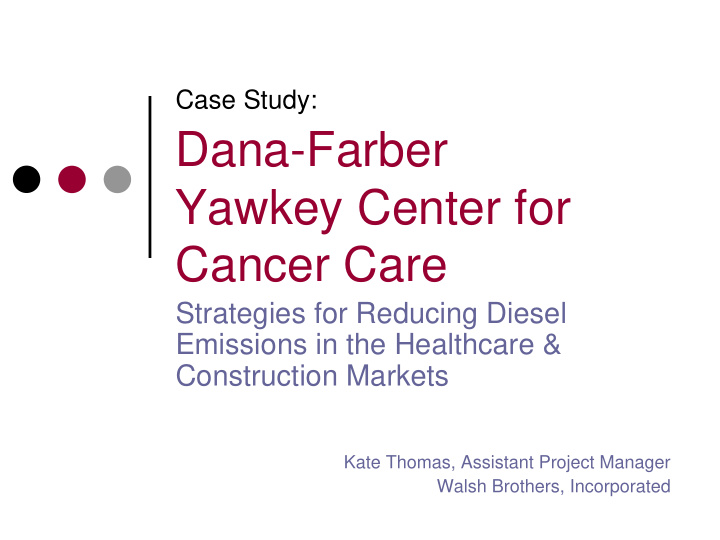



Case Study: Dana-Farber Yawkey Center for Cancer Care Strategies for Reducing Diesel Emissions in the Healthcare & Construction Markets Kate Thomas, Assistant Project Manager Walsh Brothers, Incorporated
Project Overview � Clinical Research and Treatment Facility in LMA � Near 5-Year Schedule � Dense Neighborhood
Motivation � Tasked with Mitigating Noise, Odor, Vibration � Neighborhood Relations � Patient/Guest Comfort � Planned for filtration media, no-idling. � Cold Call from GB3 � Set the wheels in motion.
The Beginning � Greater Boston Breathes Better Retrofit Seminar � Introduced to Process, Technology � Tasked WBI With Implementing Program
Program Goals � Spec Was Created with Following Goals: � Require Advanced Pollution Controls • Diesel Emissions are a known contributor to serious health problems. � Improved Air Quality for Patients and Neighborhood � Improved Air Quality for Construction Personnel � Neighborhood Relations / Good PR � Market Transformation
Executive Buy-In � Convincing Execs, Sr. Management: � Natural Choice for DFCI � Cost Feasibility � Verification of Investment, Trusted Partner � Awareness of Patient, Community and Personnel Health Issues
Executive Buy-In, con’t � Convincing Execs, Sr. Management: � Customization: • All of These = Emission Reduction Program • No Idling • Alternative Fuels • No Idling + ULSD + EPA Approved Retrofit Technologies [WBI & DFCI] • In-House Technology Testing & Verification [Harvard]
Program at YCCC � Staffing: � 1 Person, a few hours weekly. � No knowledge of engines or heavy equpment required [help from subcontractors and EPA] � Create Contract Language, Templates � Monitor Project Schedule for anticipated mobilizations � Work with Subcontractors and EPA
Contract Language � Reductions: � 42% VOC � 31% CO � 20% PM � Cleaner Fuels � Exclusive use of ULSD
Contract Language � Strict No-Idling & Turn-Off Policy � Electric Powered Equipment � Nuisance Odor Control � Away From Sensitive Receptors
Implementation: Working With Subcontractors � Program Relies Heavily on Subs � Included in Contract � Pre-Mobilization Planning � Equipment Lists � EPA Verification Numbers & Devices � Cut Sheets! � Clearly Labeled Equipment
Retrofits to Date � All DOC’s and ULSD – 21 to date. Equipment Make/Model Equipment Make/Model Crane Manitowoc 777 Excavator Cat 345 Crane Manitiwoc 10000 Excavator Cat 321 Crane Soilmec SC-120 Excavator Cat 321 Crane Tadano TR400E Excavator Cat 375 Excavator CAT M108 Gradall XL-5200 Loader Case 821C Crawler Carrier ISI-IC-45 Pump Gormann Rupp Drill Rig Casagrande C-8 Pump Thompson Drill Rig Cadagrande C-8 Excavator Komatsu PC700 Compressor Sullair 185 Excavator Komatsu PC600 Compressor Sullair 900 Excavator Cat 345
Retrofits to Date
Retrofits to Date
Planned Retrofits � 2-3 Excavators, Spring 2008 � 1 Crane, Spring 2008 � 3-5 Compressors, Ongoing � Asking Future Subs to Push Envelope � Example: A concrete sub can retrofit their pumps, but how to lessen impact of ‘dirty’ trucks bringing concrete to site?
Maintenance / Operational Impacts � NONE! � Proper Sizing Ensures Proper Performance � Routine Maintenance � Subcontractor Fears: � Impact to Equipment Performance � Impact to Fuel Consumption • [Theoretically, reduced idling saves money from less fuel consumption!]
Program Funding & Cost � All Program Costs by DFCI � < 1/1000 of total project cost � Routine Business Practice � Moral / Social / Environmental Payback � Improved Air Quality = Improved Public Health = Reduced Healthcare Costs?
Program Funding & Cost � Cost Per Vehicle � Range - $500 - $3,500 � Total Cost of Program = Less Than $125,000 � Reduced Idling Saves Fuel, Money � EPA Validation of Investment � Important to Voluntary Program � Ensures Performance and Durability
LEED / GGHC � LEED � Innovation Credit? � Incorporation into V2.3? � GGHC � Component of MRc4.2 � Diesel Program Complements Other Environmental Efforts � Indoor / Outdoor Air Quality � Environmental Management Plan
Hurdles � Learning Curve � Faith in Subcontractors � Onsite Operations � Limits the subcontractor’s ability to swap out equipment at will. � Enforcing No-Idling / Shut-Off � Verification
Positive Impacts � Market Transformation � At the forefront of a new trend. � Self-Perpetuating Cycle � Clear trend in marketplace. Subs gain experience, get more jobs. Owners talk, programs take root elsewhere. � Environmental Stewardship � PR
Positive Impacts � For DFCI: Incorporation into DFCI Master Plan � Enhance Their Mission � For WBI: Implement on New Jobs � Leaders in the Marketplace � For Subcontractors: � Marketing Tool � Benefit From Participation � Gain Retrofitted Equipment
Lessons Learned � ALL Devices EPA Approved � What Would We Change? � Length of Time Onsite? � After the initial learning curve, the program is absolutely feasible. � Subcontractors are becoming more knowledgable. � More than worth the cost.
Looking Forward � Interesting Time for Diesel Powered Equipment: � Baselines are constantly improving. � Huge Need for Retrofits: • Case Study: Sitework Contractor, Fleet = 100 pieces of Equipment • Age 15 years to New • ¼ of the Fleet is New [<5 years] • 10% of Fleet is Retrofitted • Nearly ¾ of the Fleet Needs Retrofits
Questions
Recommend
More recommend